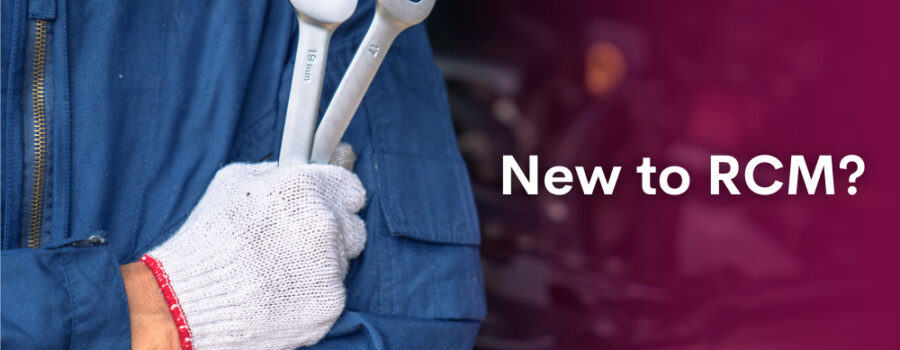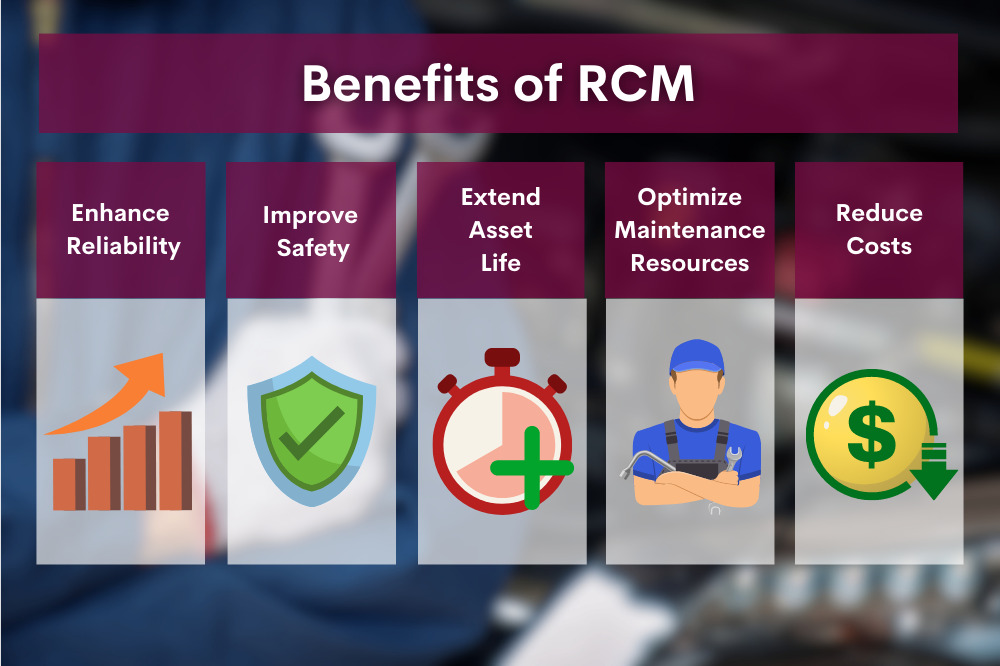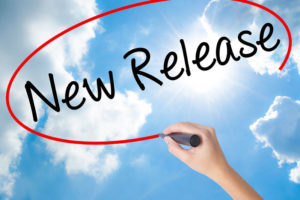Reliability Centered Maintenance, or RCM, is an organized maintenance planning methodology utilized to create an effective maintenance plan for a system in order to optimize its reliability performance. It aims to mitigate potential failures that would have a significant impact on safety, the environment, system operations, or economic factors while minimizing maintenance costs. RCM begins by assessing a system’s potential failures and the risks, causes, and both the internal and external effects of those failures. To facilitate this critical initial assessment, FMEA is often employed. Once an evaluation of system failures is complete, you then assess each potential failure mode to find an appropriate maintenance task and task interval that can be used to effectively mitigate the detrimental effects of that failure.
RCM can be performed according to well-known and established standards, such as SAE JA1011/JA1012, MIL-HDBK-2173, and NAVAIR 00-25-403. These standards provide guidelines for evaluating potential failures to determine optimal maintenance strategies. This article will review the RCM process performed in accordance with these established standards.
What is RCM?
RCM is a systematic approach to evaluating the maintenance strategies that can be used to mitigate a system’s potential failures and their detrimental effects in order to improve system reliability. Rather than relying on reactive maintenance approaches, it emphasizes proactive maintenance planning based on an understanding of a system’s potential failure modes and their consequences. RCM was initially developed by the aviation industry but has since been widely adopted across many industries, including manufacturing, automotive, and energy, to improve the asset performance.
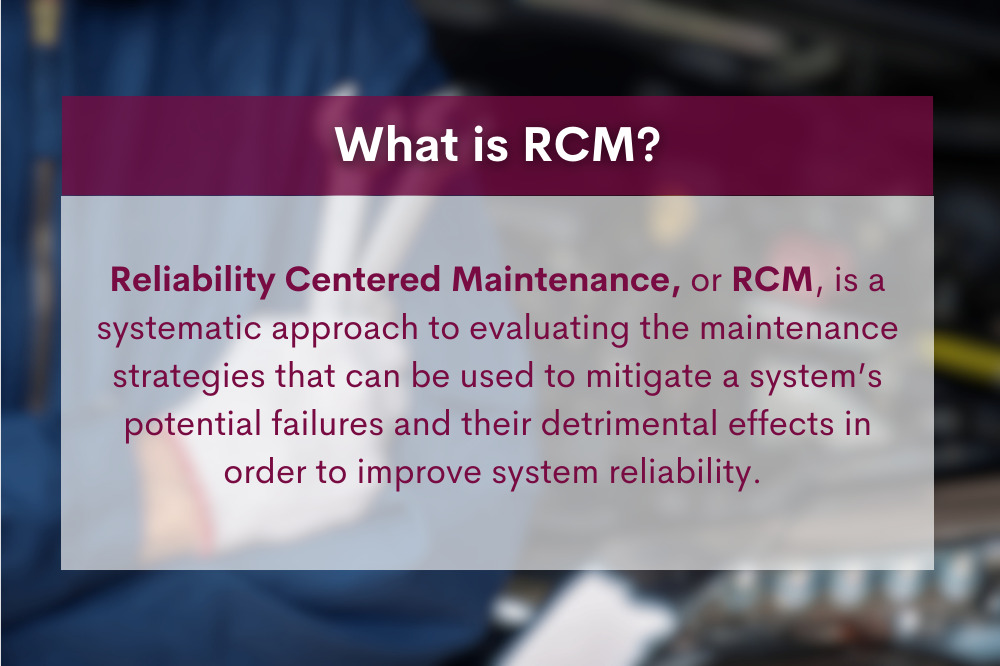
The specific RCM processes and techniques used can vary widely among industries. The SAE JA1011 standard entitled “Evaluation Criteria for Reliability-Centered Maintenance (RCM) Processes” describes the minimum criteria that a given process must comply with in order to be considered a compliant RCM process. SAE JA1011 states that, to be considered an RCM-compliant process, the method used must include the following steps performed in sequential order:
- Determine the operational context and the functions and associated desired standards of performance of the asset (operational context and functions).
- Determine how an asset can fail to fulfill its functions (functional failures).
- Determine the causes of each functional failure (failure modes).
- Determine what happens when each failure occurs (failure effects).
- Classify the consequences of failure (failure consequences).
- Determine what should be performed to predict or prevent each failure (tasks and task intervals).
- Determine if other failure management strategies may be more effective (one-time changes).
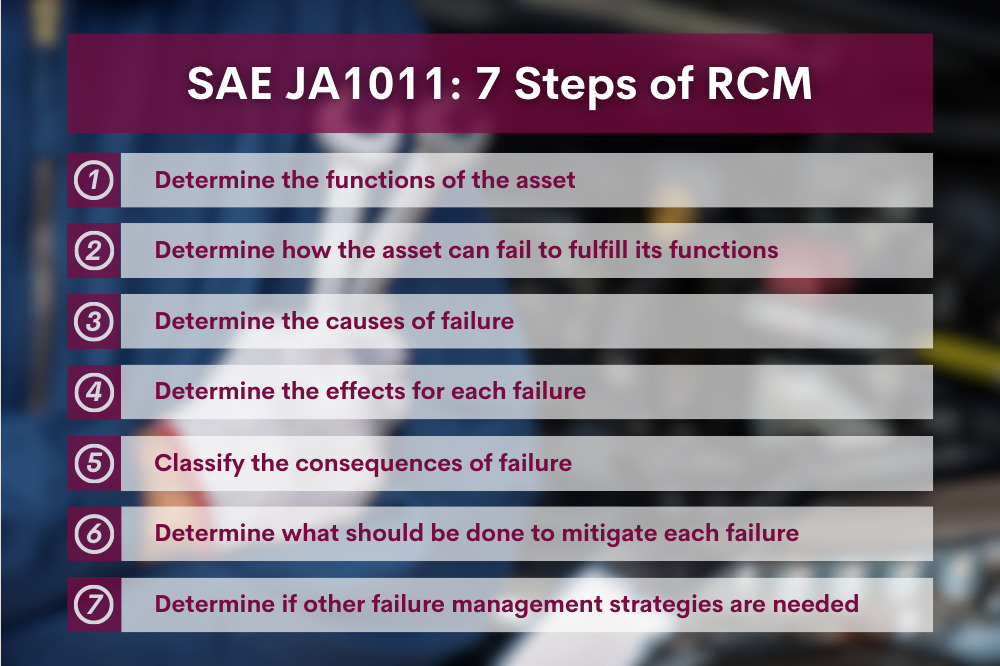
Many organizations create their own custom RCM processes based on these SAE JA1011 steps. Or, other established RCM standards such as SAE JA1012, MIL-HDBK-2173, and NAVAIR 00-25-403 can be employed. These standards offer more details on the specific methods used to evaluate potential failures to determine appropriate maintenance strategies. Many of these standards include a Decision Diagram. Decision Diagrams are flow charts of Yes/No Questions that guide RCM practitioners through the process of finding an effective maintenance task for a given potential failure.
Why should I perform RCM?
Performing RCM analysis can offer your organization a proven and effective method to improve product performance and achieve your reliability objectives. RCM’s focus on proactive maintenance planning and asset management ensures your organization’s maintenance strategy optimizes operational efficiency and safety while minimizing costs. Its methods help shift maintenance activities from a reactive approach to one that is proactive and strategic.
In some industries, such as aviation, it may be required to perform RCM analysis to meet governmental mandates and regulatory requirements. However, even in industries where RCM is not mandatory, its application can be beneficial for a number of reasons. Some of these include:
- Enhance reliability: RCM techniques provide organizations with a method to develop and implement an effective maintenance strategy. This ensures that unexpected system breakdowns and downtime are minimized, thus maximizing availability and improving reliability performance.
- Improve safety: RCM places a strong emphasis on safety by identifying potential failures modes that result in safety risks and then ensuring adequate maintenance policies are in place to mitigate that risk. This approach provides assurance that operators are kept safe from accidents and that safety regulations are met.
- Extend asset life: Through an understanding of a system’s potential failure modes, RCM offers an approach to select effective maintenance tasks that can be implemented to extend an asset’s useful operational life.
- Optimize maintenance resources: By identifying critical assets and their failure modes, RCM ensures that organizations can prioritize maintenance efforts and resources to where they are most needed.
- Reduce costs: Instead of a one-size-fits-all approach, RCM’s focus on optimizing maintenance efforts ensures the most effective maintenance tasks are selected based on asset criticality. Unnecessary maintenance activities are eliminated and system downtime is minimized, reducing overall maintenance costs.
The RCM Process
So how exactly is RCM performed? Though the specific RCM practices used can vary across organizations and industries, the general process that is followed will be similar among RCM applications.
1. Decide on an RCM Approach
There are many RCM standards in use – some of those most commonly used include SAE JA1011/JA1012, MIL-HDBK-2173, and NAVAIR 00-25-403. You may choose to follow one of these standards as-is, use one of the standards as a basis and modify it to meet your needs, or create your own unique RCM process. As long as the approach meets the key criteria as laid out in SAE JA1011, it can be considered to be an RCM-compliant process.
2. Perform Risk Analysis
Once a standard is selected, the next step is to perform risk analysis on your system to determine its Functions, Failure Modes, and associated risk data. In many RCM processes, this means performing a full FMEA (Failure Mode and Effects Analysis) on your system. Indeed, many of the commonly used RCM standards indicate that FMEA must be completed prior to moving on to the remainder of the RCM process.
Even without a compliance requirement, performing FMEA on your system prior to RCM analysis can be beneficial for many reasons. The core components of FMEA – developing a complete list of failure modes, analyzing risks, and determining failure causes and effects – are all beneficial and needed for an effective RCM process. Performing FMEA ensures you have a valuable understanding of your system’s most critical potential failures prior to beginning your Reliability Centered Maintenance analysis.
However, it is not required to complete a full FMEA in order for a process to be deemed to be RCM compliant. According to SAE JA1011, the required pieces of information for RCM processes are a system’s functions, functional failures, potential failure modes, and effects. Note that this means RCM processes are not required to include additional FMEA information such as risk metrics and recommended actions.
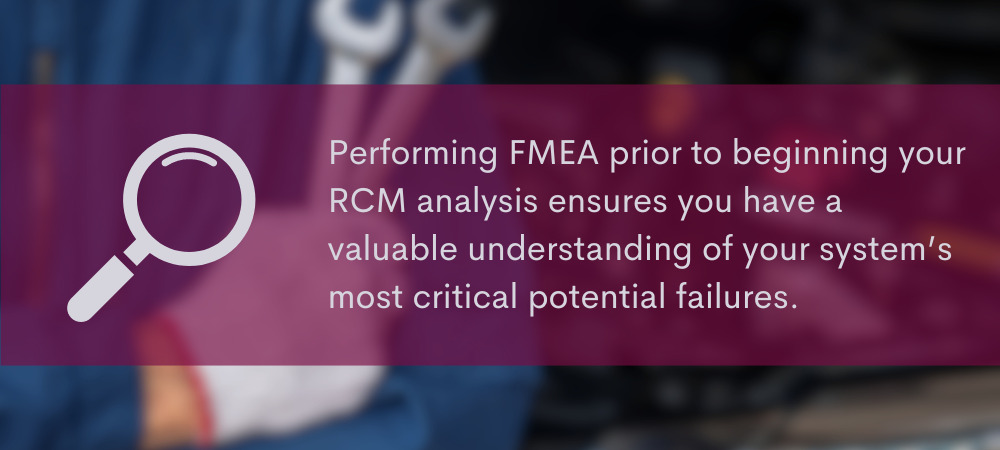
3. Classify Failure Modes
After risk analysis is completed, the next step in the RCM process is to classify each failure mode based on its Failure Consequences. In RCM, Failure Consequences are used to classify potential failures based on various aspects, such as the failure’s visibility to its users and its impact on the overall system and environment. Failures are often classified as those that are Hidden or Evident to the system’s users and those that impact Safety, Environmental, or Economic factors.
In many applications of RCM, this step is completed with the aid of an RCM Decision Diagram. The RCM Decision Diagram provides a flow chart of Yes/No Questions designed to guide practitioners through the RCM process. The Questions provide a way to determine the appropriate Failure Consequence classification for each potential failure based on its effects. Depending on their Failure Consequence classification, certain failures are often considered higher in priority, such as those that affect Safety, compared to others, such as those that affect only Economic factors. This influences the selected maintenance strategy, as those failures that affect Safety may require more robust, and therefore more costly, maintenance strategies.
4. Determine Maintenance Tasks
Once a failure mode’s Failure Consequences are determined, the next step in the RCM process is to determine appropriate Maintenance Tasks that can be used to mitigate that potential failure’s risk.
Some of the most commonly used Maintenance Task types in RCM include:
- On-Condition – tasks to identify a potential failure before it occurs. They can often involve checking an item’s condition or running a diagnostic check.
- Repair and Restoration Processes – tasks to restore an item to an improved operating condition. They are often scheduled at specified internals and are performed regardless of the item’s condition.
- Discard and Replace – tasks to identify an item that should be replaced. Similar to Repair and Restoration processes, they are often scheduled at specified intervals regardless of item condition.
- Failure-finding – tasks to verify if a given failure mode has occurred. These tasks apply to failure modes with Hidden Failure Consequences only.
- Run-to-Failure – indicated no maintenance tasks are designated. This represents a reactive maintenance strategy that means a given failure mode is permitted to occur and the item will be repaired or replaced only upon failure. This is sometimes the most efficient strategy when balancing the risk of failure with the cost of performing maintenance activities.
These tasks may be used on their own or in combination with one another to mitigate a given failure mode’s risk.
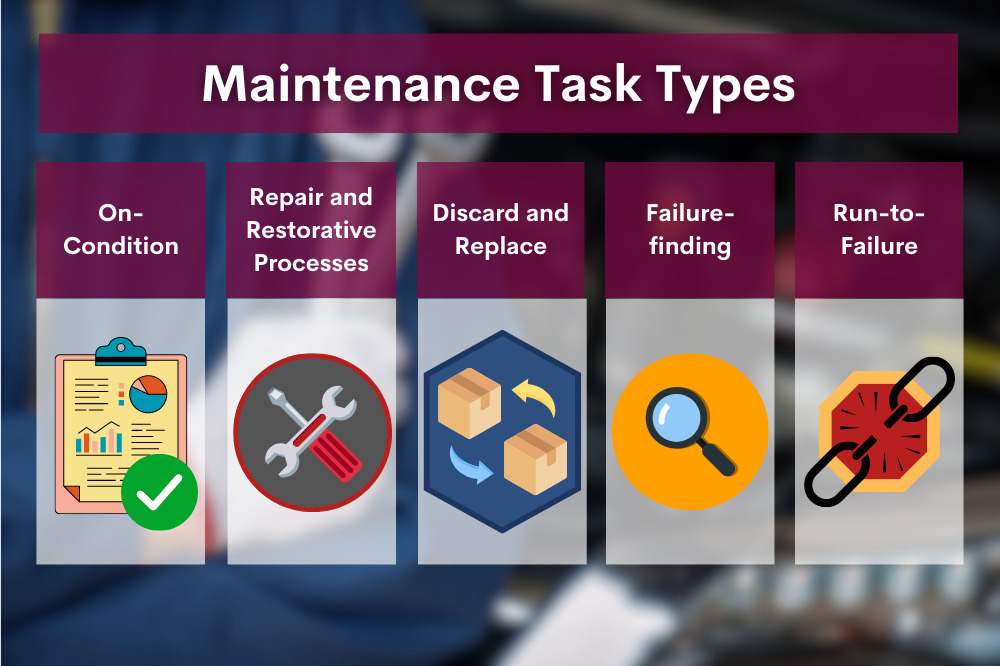
Finding appropriate Task Types
The appropriate Task types for a given failure mode may be affected by its Failure Consequence classification. For example, a failure that is hidden from the operator may require an operator check to determine if the failure has occurred. This type of Task would not be applicable for a failure whose occurrence is evident to the operator during operation. In this way, Failure Consequences in RCM can help ensure that each failure is appropriately managed with a maintenance strategy that is appropriate and effective.
In applications of RCM that follow a commonly used RCM standard such as SAE JA1012 or MIL-HDBK-2173, the Decision Diagram is again employed to assist in the Maintenance Task selection process. Tasks are analyzed in a progressive order as you proceed through the Decision Diagram. That is, those Tasks that are generally found to be the most effective for a certain failure mode are analyzed first. In this way, the Decision Diagram helps to ensure maintenance analysis is conducted in an organized, methodical way and that the resulting maintenance strategy is both cost-efficient and effective.
Sometimes, you may find that certain failure modes do not have an appropriately applicable and effective Task that can be associated with them. Based on that failure’s Failure Consequences, you may decide that a redesign is needed – for example, if Safety-related failures cannot be mitigated by a Maintenance Task. Or, you may deem that scheduled maintenance measures are not required. For example, if a failure with only Economic effects cannot be effectively mitigated by other means, you may decide that a run-to-failure approach is appropriate.
5. Complete RCM Worksheet
After a recommended Maintenance Task Type is determined for a given Failure Mode, the RCM process continues by moving to the RCM Worksheet. The RCM Worksheet is where you define the specific maintenance details and schedules for each failure mode. This can include information such as Task Number, Description, Task Interval, and any other details needed to properly define each Task.
Once the Maintenance Task details on the RCM Worksheet are completed, the RCM analysis process is concluded. At this point, the completed RCM Worksheet becomes the maintenance plan for your system.
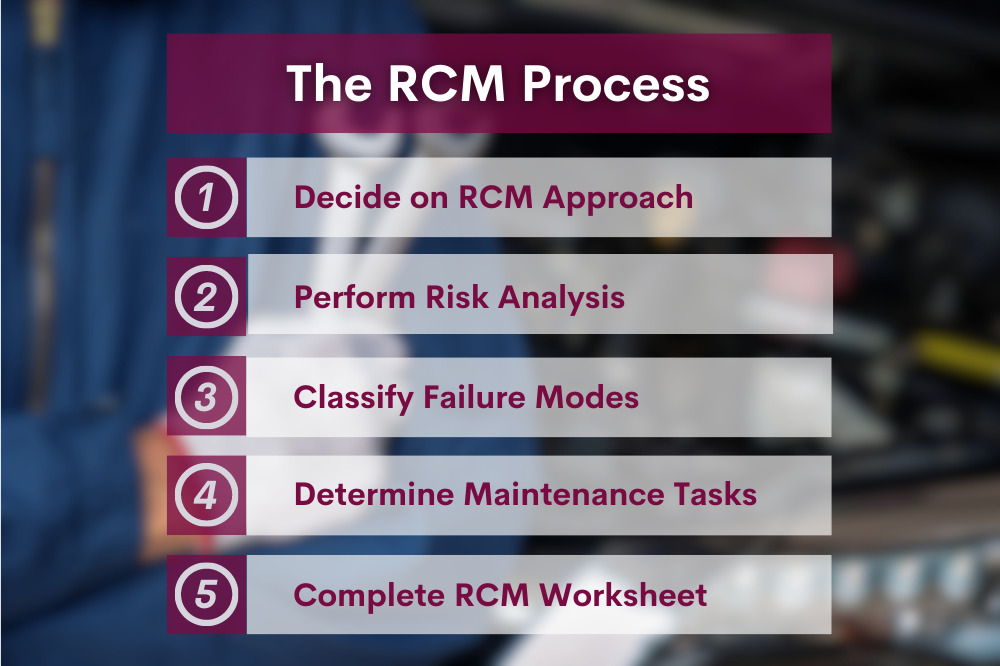
Example RCM
To better understand the RCM process, we will consider a simple example analysis of an in-house air conditioning unit.
1. Decide on an RCM Approach
We decide to base our RCM process from the approach as laid out in the SAE JA1012 standard with some minor modifications to its example Decision Diagram to better suit the analysis of an AC unit.
2. Perform Risk Analysis
To perform risk analysis for our system, we decide to use a dedicated FMEA software tool. For complete RCM analysis of the AC unit, FMEA should be performed on our entire system to develop a full list of failure modes and associated risk data for RCM. However, for the purposes of this example case, we will consider only a single failure mode of Restricted airflow to evaporator coil and its FMEA information shown below:

3. Classify Failure Modes
Next, we proceed through our Decision Diagram to find the failure mode’s Failure Consequence classification. Our Diagram is based on the SAE JA1012 standard with some minor modifications to better suit an AC unit system. A summary of the resulting Decision Diagram Question and Answer data to find the Failure Consequence classification is shown below:
Question: Will the loss of function caused by this failure mode be evident to the occupants?
Answer: Yes. Occupants will notice the unit’s inability to maintain the temperature as set on the thermostat.
Question: Is there a risk that the effects of this failure mode could injure someone?
Answer: No. Based on our FMEA data, the most severe effect that is expected should this failure mode occur is that the house exceeds its maximum thermostat temperature.
Question: Is there a risk that the effects of this failure mode could breach a known environmental standard or regulation?
Answer: No. Based on our FMEA data, this failure mode is caused by a clogged air filter. This does not breach any known environmental standard.
Question: Does the failure mode affect operational capability?
Answer: Yes. This failure mode affects the unit’s ability to properly regulate house temperature.
Based on these answers, our failure mode has been classified to have Evident, Economic Failure Consequences.
4. Determine Maintenance Tasks
With our Failure Consequence classification determined, our next step is to determine an appropriate Maintenance Task that can be used to mitigate the failure mode being analyzed. Again, with the help of our Decision Diagram, we determine that a scheduled Discard and Replacement task of the air filter is appropriate for this failure mode. We also evaluated On-Condition tasks but deemed they would not be suitable for this failure mode as there is no easily identifiable or quantifiable condition that reliably predicts the failure before it occurs.
Now that we have determined the failure mode’s Failure Consequences classification and an appropriate Maintenance Task Type, our Decision Diagram is complete as shown below in Relyence RCM:

5. Complete RCM Worksheet
We now move on to the RCM Worksheet to add information about the specific Maintenance Tasks involved in the maintenance program for our failure mode. In this case, we decide that a Task Interval of 3 months for the Discard and Replacement task is sufficient for this Failure Mode. Our completed RCM Worksheet for the failure mode of Restricted airflow to evaporator coil is shown below.

To complete a full RCM analysis on our air-conditioning unit, we would follow a similar process for all of our system’s failure modes. Our resulting RCM Worksheet would then provide details on the maintenance plan required to properly manage all of the system’s potential failures.
Contact Us to Learn More About Relyence RCM!
With the amount of information required to perform RCM analysis, including both the risk analysis and maintenance plan data, it is evident that a software tool designed for the job can provide many advantages. Relyence RCM was designed to be an intuitive and powerful tool to ensure you get the most out of your RCM analyses. Relyence RCM facilitates the use of the RCM methodology as laid out in standards such as SAE JA1011 and JA1012, MIL-HDBK-2173, and NAVAIR 00-25-403.
Relyence RCM comes supplied with several commonly used RCM elements and additional features that are designed to make your RCM process as effective as possible. The Guided Decision Diagrammer makes efficient work of building and navigating your Decision Diagrams, built-in Diagram and Worksheet customization means you can tailor the RCM process to your needs, and seamless integration with Relyence FMEA including the FMEA Insight capability ensures your risk analysis data is automatically synchronized and available at the click of a button.
To learn more about our RCM software, contact us today, schedule a personalized 1-on-1 demonstration, or sign up for our free trial to see Relyence RCM and the rest of the Relyence Studio integrated reliability and quality tool suite for yourself!

